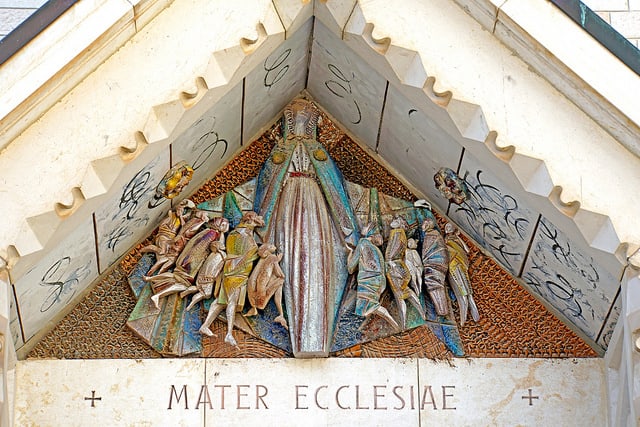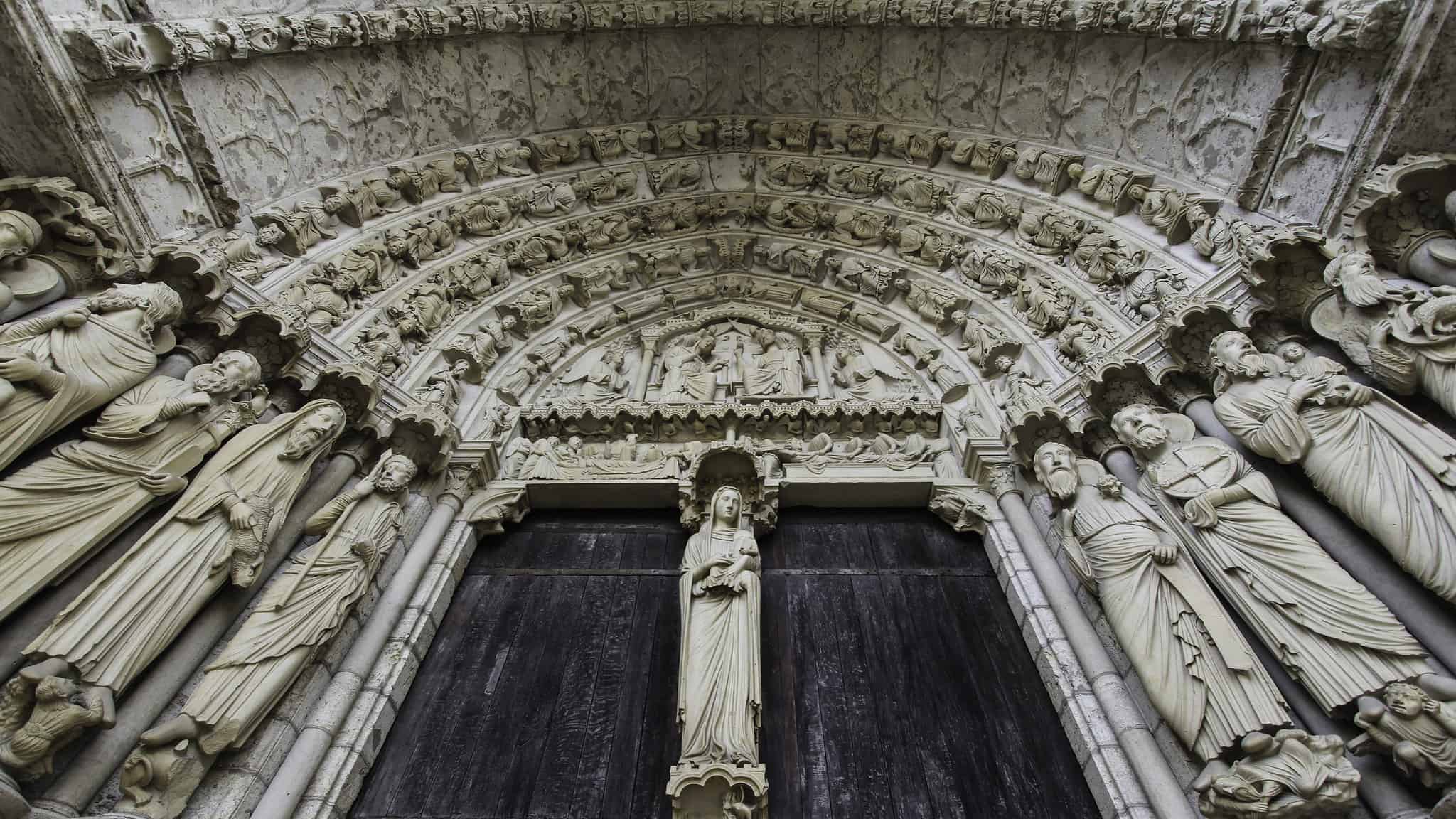One of the things I love most about being Catholic is the sheer volume of details—names, places, images, practices, etc.—that make up our Church. It would take multiple lifetimes to investigate the half of them. Every so often, I like to dig a little bit deeper into one of these details. It seems that no matter what I investigate, I always come away with my faith deepened and understanding expanded.
My most recent side-project has been looking into the history of the title of Mary: Mother of the Church. It’s a strange title for Mary for several reasons – although, really, which title for Mary is not strange? We’re dealing with supernatural mysteries here! It’s one of the most recently-awarded titles for her, only being proclaimed officially by Pope Paul VI in 1964. In Latin, the title is distinguished from another frequently-used Latin phrase by only one letter. “Mother of the Church” is Mater Ecclesiae, while “Mother Church” is Mater Ecclesia.
The image of the Church (rather than Mary) as mother was frequently employed by early Christian writers and artists. Perhaps the popularity of referring to the Church as mother led Bishop Sergio Méndez Arceo (Cuernavaca, México), during the debate over the title at Vatican II, to crack irreverently, “If the Church is our mother and Mary is the Mother of the Church, then Mary is our grandmother.”1
*****
The origin of the official title goes back to the Second Vatican Council, where Mary was a contentious topic. During the second session of the council in 1963, the bishops voted 1,114-1,074 not to dedicate a separate document to Mary alone, but rather to include the theme of Mary in the constitution addressing the Church (what eventually became Lumen Gentium). With a difference of just 40 votes, this was by far the most contentious vote at the Council.
Nevertheless, a year later, while promulgating the completed Lumen Gentium (or, the Dogmatic Constitution on the Church), Pope Paul VI proclaimed Mary “Mother of the Church” in a discourse closing the third session. The pope thus made this title official, certainly to the delight of those on the losing side of the narrow vote, who generally supported expanding Mariological doctrine to its maximum extent.

Since Vatican II, elements celebrating Mary as Mother of the Church have been added to the Church’s life and practice. For instance, the votive Mass of Our Lady, Mother of the Church, was added to the Roman Missal after the Council.2 Pope St. John Paul II had a monastery built on the grounds of the Vatican and dedicated it to Mary under this title. (This monastery currently serves as the residence of Pope Benedict XVI.) He also added “Mother of the Church” to the Litany of Loreto, the great Marian prayer invoking her intercession under various titles.3
The way in which the Church invokes Mary under the title Mother of the Church can be our guide into exactly what mystery this title means to convey. We can start with the text of Lumen Gentium itself, which claims that Mary cooperates with her Son in “giving back supernatural life to souls. Wherefore she is our mother in the order of grace.” (LG 61) Clearly, a biological mother’s function is to give life to her offspring. Mary physically gave life to Jesus, but her motherhood toward us members of the Church is of course different. Her motherhood to us is of a spiritual kind: she increases the life of grace in us.
So what does that mean? How exactly does the life of grace increase in us? Insofar as we are conformed to Christ’s life, we grow in the life of grace. And which person participated in the mysteries of the life of Christ in a preeminent way? Mary, of course. It was she who carried Jesus in her womb. She stood by while He hung on the Cross. She was present in the Upper Room, praying with the first Christian community, awaiting the gift of the Holy Spirit for all believers (Acts 1:14). Finally, she was assumed body and soul into heaven in imitation of her Son. These four moments in Mary’s life exemplify her close participation in the mysteries of the life of her Son.4
What about the rest of us, though? Are we able to participate in Christ’s life? Thankfully, the answer is yes. Pope Paul VI explains in his Credo of the People of God, “the Lord Jesus forms His Church by means of the sacraments emanating from His plenitude. By these she makes her members participants in the Mystery of the Death and Resurrection of Christ, in the grace of the Holy Spirit who gives her life and movement.” For us Christians, the life of grace begins with the sacraments. Jesus left the them to the Church as the means by which we may participate in, and therefore conform ourselves to, His life.
*****
Mary understood better than anyone the benefits of being united to the mysteries of Christ. Mary desires that all humans receive what she received, so she works through the Church to give Her Son to us.
It is not as Bishop Méndez Arceo claimed. Mary doesn’t give birth to the Church, which then gives birth to Christians (making Mary a “grandma”). The Church is Christ’s Mystical Body, and Mary is the mother of the members of this Body. In a sense, the Church can be called a mother, too, because she provides the sacraments for her members. But the sacraments are provided by the members of this Body themselves. Priests provide the Eucharist. Spouses provide marriages. Bishops provide priests. This line of reasoning led the Church to the recent realization that if the Church has the characteristics of a mother, insofar as she gives birth to new Christians, this characteristic is derivative from the motherhood of Mary. From this perspective, the title “Mother of the Church” is aptly bestowed on Mary.
Pope Paul VI declared his desires for the Christian people in the same 1964 discourse, “We trust then, that with the promulgation of the Constitution on the Church, sealed by the proclamation of Mary as Mother of the Church, that is to say of all the faithful and all the pastors, the Christian people may, with greater ardor, turn to the Holy Virgin and render to her the honor and devotion due to her.” I hope that this dive into the title of Mary, Mother of the Church, will deepen your own faith and that you might entrust yourself to her in a way that helps the life of grace grow within you.
***
Image courtesy FlickrCC users Lawrence OP and Dennis Jarvis.
- This seems like a wisecrack one of my seventh graders might make in class. I would have to reprimand him, while at the same time saying to myself, “Good point, kid.” Bishop Méndez Arceo was reprimanded the day after for his comment. ↩
- Fun trivia: Pope Francis celebrated this votive Mass in Philadelphia during his visit to the United States in September 2015. ↩
- John Paul II, a pope of great Marian devotion, also added the title “Queen of Families” to the Litany during his pontificate. ↩
- Not surprisingly, these moments are highlighted by the prayers of the Mass of Our Lady, Mother of the Church, especially in the Eucharistic Preface. ↩


